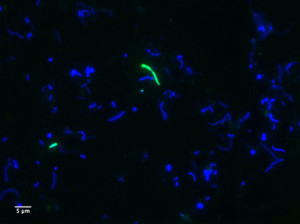Biases in current sequencing technologies hide true breadth of microbial diversity.

This study complements work done by a DOE JGI team in uncovering the novel candidate bacterial phylum Kryptonia. (Composite image by Emiley Eloe-Fadrosh, DOE JGI)
The Science
DOE JGI researchers employed datasets from the Integrated Microbial Genomes (IMG) system to determine how many microbial lineages might be missed from available sequences in existing datasets due to mismatches with currently used Polymerase Chain Reaction (PCR) primers. PCR is a technology used for amplifying a single copy of a DNA strand several orders of magnitude.
The Impact
Uncovering the planet’s true microbial diversity may lead to microbes whose metabolic pathways and genes could be useful in a wide range of applications. Identifying biases in current sequencing technologies could help researchers find methods for describing additional phylogenetic lineages.
Summary
In a study published January 27, 2016 in Nature Communications, a team led by researchers at the U.S. Department of Energy Joint Genome Institute (DOE JGI), a DOE Office of Science User Facility, utilized the largest publicly available collection of metagenomic datasets to uncover a completely novel bacterial phylum that they have dubbed “Kryptonia.” In a complementary article published February 1, 2016 in Nature Microbiology, DOE JGI researchers wondered how many other microbial lineages might have been missed, as Kryptonia had been, due to being overlooked by the PCR primers most commonly used in these kinds of analyses. With help from the National Energy Research Scientific Computing Center (NERSC), the team analyzed more than 50,000 16S genes –gene sequences that are found in every microbe and can serve as an identifying marker – from metagenomic datasets and were able to find that as much as 10 percent of those sequences would be missed by the currently used PCR primers. The team then asked how many of those sequences might be unaffiliated with currently known microbial lineages and found what DOE JGI Prokaryote Super Program Head Nikos Kyrpides described as “a significant number of genes that could represent novel microbial phyla.” The team was also able to pinpoint specific habitats that could harbor most of the novel sequences. In addition to revealing more of the “microbial dark matter,” the vast realm of as-yet-undiscovered microbes on Earth, this work will help better characterize the responses of microbial life to environmental changes.
Contacts
Daniel Drell, Ph.D.
Program Manager
Biological Systems Sciences Division
Office of Biological and Environmental Research
Office of Science
US Department of Energy
daniel.drell@science.doe.gov
Nikos Kyrpides
Prokaryote Super Program Head
DOE Joint Genome Institute
nckyrpides@lbl.gov
Funding
- DOE Office of Science
Publications
- Eloe-Fadrosh EA et al. Metagenomics uncovers gaps in amplicon-based detection of microbial diversity. Nat Microbiol. 2016 Feb 1. doi: 10.1038/nmicrobiol.2015.32.
- Eloe-Fadrosh EA et al. Global metagenomic survey reveals a new bacterial candidate phylum in geothermal springs. Nat Commun. 2016 Jan 27;7:10476. doi: 10.1038/ncomms10476.